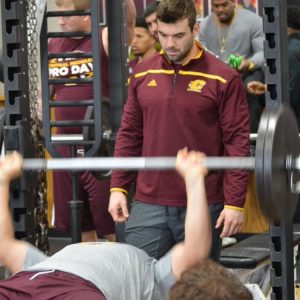Physio Ball Exercises – The physio ball is an extremely versatile piece of equipment that is used for a multitude of purposes across a broad range of professional fields. It is commonly referred to by a host of different names which is fitting given its wide range of usage. You may know the physio ball as an exercise ball, swiss ball, balance ball, or therapy ball, among many other names depending on its intended use. Within the strength and conditioning field alone, physio ball exercises can be used for a wide range of purposes. The versatility and practicality of a physio ball, paired with its relative affordability for large quantities, makes it a staple in many weight rooms.
Purpose and Practical Uses:
For S&C practitioners, physio ball exercises are most commonly used for improving stability, balance, coordination and even strength training. Due to the fact that it is a ball, and thus an extremely unstable surface, it is not an ideal piece of equipment for improving general strength and power for an athlete. However, the physio ball can still be used for strength training by focusing on the core and its associated muscles, as well as improving posterior chain and inner thigh strength.
Athletes undergoing rehab assignments often benefit from using a physio ball, as the unstable surface helps activate deep or weakened musculature from injury or infrequent use. It is also used as a prehab or injury prevention tool when placed into a training program. The physio ball relies on the athlete to activate specific musculature used for balance and stabilization and therefore, can be used for pre-activity activation as well. Common musculature that can be activated via stabilization are the transverse abdominis, multifidi group and the hip rotators.
General Physio Ball Exercises to Perform:
Core exercises: rollouts, circles, alphabet, numbers, knee tucks, pike-ups, V-ups, back extensions, oblique crunches, oblique iso-holds, P-Ball exchanges (hands to feet) and prone marches
Lower-body Physio Ball Exercises: Groin squeezes, rear foot elevated squat, single-leg groin push away, straight-leg bridge, bent-leg bridge and hamstring curls
Upper-body Physio Ball Exercises: Upper back work (I,Y,Ts) (thumbs up raise for mid trap, pinkies up raise for rhomboids), partner movement stabilization high plank, and wall slide shoulder activation
Modifications for usage:
The physio ball may be used in conjunction with other equipment (i.e. dumbbells), however, just because it is possible does not necessarily mean it is always appropriate. Whenever using another piece of equipment with the physio ball, be very cautious of problems that may occur because of its unstable surface. The physio ball is not recommended for use to gain absolute strength or power, however, it can be used as a means to sub-maximally resistance train.
A great modification for usage is to teach certain exercises such as a squat. When the physio ball is against the wall it allows for a beginner, or someone who needs no added resistance, to achieve appropriate depth while still being supported by the ball.
Programming Purposes:
As previously mentioned, the physio ball is not the ideal tool to build absolute strength and power for athletes, so basing your entire program around it is not recommended if those are your goals. However, physio ball exercises can serve a great purpose and are an excellent supplement to most workout programs. Based on their low cost, a physio ball is also a great way to add programming options on a limited budget. They also give coaches the opportunity to develop young athletes without traditional weights.
The most practical usage of the physio ball will typically be late in the workout after any explosive lifts or multi-joint strength/power exercises are completed. Physio ball exercises are typically reserved for accessory work, placed within super-sets or monster-sets, and are great for any type of circuit training. The majority of the exercises utilizing the ball will be bodyweight, and experienced athletes can do higher-rep schemes to reach volitional failure. Depending upon training age and caliber of athlete, the physio ball may be purposefully used earlier in a workout to fulfill needs that benefit proprioceptive qualities.
As with any piece of equipment, the sky is the limit in terms of usage. Be creative and imaginative with its use, but always make sure to have a valid reason behind anything you do with an athlete.

Joe Powell is an Assistant Strength & Conditioning Coach at Utah State University. He formerly held a similar position at Central Michigan University where he also taught classes in the Department of Health and Human Performance. Joe is a regular contributor to the IYCA Insiders program and has been a huge part of bringing the Behind the Science series to the IYCA. He is also the author of the IYCA Guide to Manual Resistance Strength Training. Get more of Joe’s contributions in the IYCA Insiders membership.


